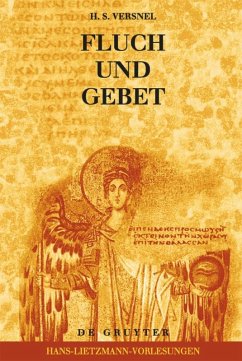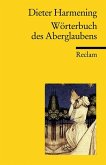This study touches on the vexed issue concerning the relationship of magic and religion, a problem that, despite all claims to the contrary, stubbornly resists losing interest and import. A close reading of ancient Geek and Latin curses written on lead tablets reveals a never fully explored demarcation in terms of legitimacy and illegitimacy between two types. Binding curses (defixiones), on the one hand, were meant to ?bindâ??? that is render powerless? opponents or rivals. Buried in graves, pits or wells, they lacked references to the notion of justification and displayed words and actions of a manipulative nature that modern readers would associate with what we call magic. Marked by secrecy, they were liable to suspicion and social disapproval. Another category of curses on lead, albeit also categorized as defixiones in modern scholarly literature, appears to be of a radically different nature. Often publicised in temples they implored the local god to punish a (mostly) unknown person for having wronged (by theft, slander, or maltreatment) the author. Besides a markedly deferential tone and an attitude of submissiveness, various other characteristics reveal these texts as prayers for justice, thus in our perception being expressions of pious religiosity. The fact that the ancient users were aware of the distinction and acted accordingly evokes a reconsideration of the use of modern notions magic and religion for ancient Greek and Roman curse practice.
Der Leidener Althistoriker Henk Versnel berührt in dieser Studie das komplizierte Verhältnis von Magie und Religion, welches sich trotz aller gegenteiligen Behauptungen hartnäckig einem Bedeutungs- und Interesseschwundes widersetzt. Die genaue Lektüre von antiken griechischen und lateinischen Fluchtafeln macht eine bisher nicht hinreichend erforschte Unterscheidung in zwei Kategorien möglich. Auf der einen Seite finden sich Bindeflüche (defixiones), die durch "Bindung" Kontrahenten oder Rivalen aller Kraft berauben sollten. In Gräbern, Gruben oder Brunnen versteckt, zeigen sie keinerlei Erwähnung von Rechtfertigung und verwenden Worte und Handlungen manipulativer Art, die moderne Leser als "magisch" bezeichnen würden. Ihr anonymer Gebrauch machte sie anfällig für Verdächtigungen und soziale Ablehnung. Ein zweiter Typus von Fluchtafeln, der in der wissenschaftlichen Literatur ebenfalls als defixiones bezeichnet wird, scheint von grundlegend anderer Natur zu sein. Meist öffentlich in Tempeln angebracht bitten sie die örtliche Gottheit, eine (meist) unbekannte Person für ein am Verfasser begangenes Unrecht (Diebstahl, Verleumdung oder schlechte Behandlung) zu strafen. Der erkennbar respektvolle Ton, eine demütige Haltung sowie weitere Charakteristika erweisen diese Texte als Gebete für Gerechtigkeit, in unserer Wahrnehmung also Ausdrücke einer frommen Religiosität. Die Tatsache, dass die antiken Menschen zwischen beiden Typen zu unterscheiden wussten und entsprechend handelten, gibt Anlass, die Anwendung der modernen Begriffe "Magie" und "Religion" auf die antike griechische und römische Fluchpraxis neu zu überdenken.
Der Leidener Althistoriker Henk Versnel berührt in dieser Studie das komplizierte Verhältnis von Magie und Religion, welches sich trotz aller gegenteiligen Behauptungen hartnäckig einem Bedeutungs- und Interesseschwundes widersetzt. Die genaue Lektüre von antiken griechischen und lateinischen Fluchtafeln macht eine bisher nicht hinreichend erforschte Unterscheidung in zwei Kategorien möglich. Auf der einen Seite finden sich Bindeflüche (defixiones), die durch "Bindung" Kontrahenten oder Rivalen aller Kraft berauben sollten. In Gräbern, Gruben oder Brunnen versteckt, zeigen sie keinerlei Erwähnung von Rechtfertigung und verwenden Worte und Handlungen manipulativer Art, die moderne Leser als "magisch" bezeichnen würden. Ihr anonymer Gebrauch machte sie anfällig für Verdächtigungen und soziale Ablehnung. Ein zweiter Typus von Fluchtafeln, der in der wissenschaftlichen Literatur ebenfalls als defixiones bezeichnet wird, scheint von grundlegend anderer Natur zu sein. Meist öffentlich in Tempeln angebracht bitten sie die örtliche Gottheit, eine (meist) unbekannte Person für ein am Verfasser begangenes Unrecht (Diebstahl, Verleumdung oder schlechte Behandlung) zu strafen. Der erkennbar respektvolle Ton, eine demütige Haltung sowie weitere Charakteristika erweisen diese Texte als Gebete für Gerechtigkeit, in unserer Wahrnehmung also Ausdrücke einer frommen Religiosität. Die Tatsache, dass die antiken Menschen zwischen beiden Typen zu unterscheiden wussten und entsprechend handelten, gibt Anlass, die Anwendung der modernen Begriffe "Magie" und "Religion" auf die antike griechische und römische Fluchpraxis neu zu überdenken.








